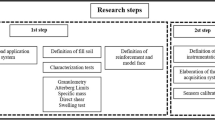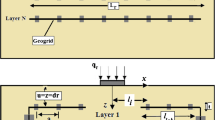Abstract
Lade’s single hardening soil model with Cosserat rotation embodied in the finite element method is employed to investigate the behavior of geosynthetic reinforced soils with special attention to the development of shear banding. The ability of the finite element model to detect shear banding in a reinforced soil is examined against three high quality small-scale laboratory plane strain tests on Toyoura sand with and without reinforcement. These three tests were chosen because of the clear failure surfaces that developed in the soil during loading. The FEM analyses were able to reasonably simulate the plane strain laboratory tests including both unreinforced and reinforced cases. The FEM analyses gave reasonably good agreement with the experimental results in terms of global stress–strain relationships and shear band occurrences. Furthermore, and based on FE analyses of a hypothetical geosynthetic reinforced soil (GRS) retaining wall, it is shown that the geosynthetic reinforcements are very effective in hindering the formation of shear bands in GRS retaining walls when small spacing between the reinforcement layers was used. When used properly, the geosynthetic reinforcements made the soil behave as a truly reinforced mass of considerable stiffness and strength.
























Similar content being viewed by others
References
Alsaleh MI (2004) Numerical modeling of strain localization in granular materials using Cosserat theory enhanced with microfabric properties. Ph.D thesis, Louisiana State University
Alsaleh MI, Voyiadjis GZ, Alshibli KA (2006) Modelling strain localization in granular materials using micropolar theory: mathematical formulations. Int J Numer Anal Methods Geomech 30:1501–1524. doi:10.1002/nag.533
Alshibli KA, Alsaleh MI, Voyiadjis GZ (2006) Modelling strain localization in granular materials using micropolar theory: numerical implementation and verification. Int J Numer Anal Methods Geomech 30:1525–1544. doi:10.1002/nag.534
Bauer E, Huang W (2001) Influence of density and pressure on spontaneous shear band formations in granular materials. In: Symposium on theoretical and numerical methods in continuum mechanics of porous materials, pp 245–250
Cosserat E, Cosserat F (1909) Theory des corps deformables. Herman et fils, Paris
Fukushima S, Tatsuoka F (1984) Strength and deformation characteristics of saturated sand at extremely low pressures. Soil Found 24(4):30–48
Gudehus G, Nubel K (2004) Evolution of shear bands in sand. Geotechnique 54(3):187–201. doi:10.1680/geot.54.3.187.36346
Huang W, Nubel K, Bauer E (2002) Polar extension of a hypoplastic model for granular materials with shear localization. Mech Mater 34:563–576. doi:10.1016/S0167-6636(02)00163-1
Kim MK, Lade PV (1988) Single hardening constitutive model for frictional materials, I. Plastic potential function. Comput Geotech 5:307–324. doi:10.1016/0266-352X(88)90009-2
Kotake N, Tatsuoka F, Tanaka T, Siddiquee MSA, Yamauchi H (1999) An insight into the failure of reinforced sand in plane strain compression by FEM simulation. Soil Found 39(5):103–130
Lade PV, Kim MK (1988) Single hardening constitutive model for frictional materials, II. Yield criterion and plastic work contours. Comput Geotech 6:13–29. doi:10.1016/0266-352X(88)90053-5
Lade PV, Nelson RB (1987) Modelling the elastic behavior of granular materials. Int J Numer Anal Methods Geomech 11:521–542. doi:10.1002/nag.1610110507
Lai TY, Borja RI, Duvernay BG, Meehan RL (2003) Capturing strain localization behind a gesynthetic-reinforced soil wall. Int J Numer Anal Methods Geomech 27:425–451. doi:10.1002/nag.280
Pasternak E, Mühlhaus HB (2002) Large deformation Cosserat continuum modeling of granulate materials. In: Applied mechanics ACAM 2002, pp 389–396
Rankine W (1857) On the stability of loose earth. Philos Trans R Soc Lond 147:9–27. doi:10.1098/rstl.1857.0003
Rubin MB (2000) Cosserat theories: shells, rods and points-solids mechanics and its applications. Kluwer, Dordrecht
Tatsuoka F, Molenkamp F, Torii T, Hino T (1984) Behavior of lubrication layers of platens in element tests. Soil Found 24(1):113–128
Tejchman J, Bauer E (1996) Numerical simulation of shear band formation with a polar hypoplastic constitutive model. Comput Geotech 19(3):221–244. doi:10.1016/0266-352X(96)00004-3
Tomantschger KW (2002) A boundary value problem in the micropolar theory. Zamm Z Angew Math Mech 82(6):421–422. doi :10.1002/1521-4001(200206)82:6<421::AID-ZAMM421>3.0.CO;2-P
Vardoulakis I, Sulem J (1995) Bifurcation analysis in geomechanics. Blackie Academic and Professionals, Glasgow
Author information
Authors and Affiliations
Corresponding author
Rights and permissions
About this article
Cite this article
Kitsabunnarat, A., Alsaleh, M. & Helwany, S. Capturing strain localization in reinforced soils. Acta Geotech. 3, 175–190 (2008). https://doi.org/10.1007/s11440-008-0078-8
Received:
Accepted:
Published:
Issue Date:
DOI: https://doi.org/10.1007/s11440-008-0078-8




